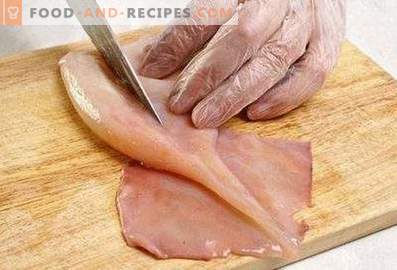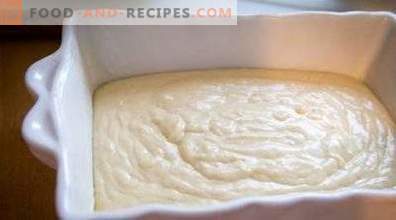
Squids are cephalopods that are a very valuable and nutritious product. With them you can perfectly diversify the diet, because of them are cooked and soups, and salads, and snacks. In addition, these shellfish are perfectly combined with a side dish of vegetables and cereals.
Many hostesses bypass these seafood side for one simple reason: first of all, squid must be cleaned. Yes, in this process there are many subtleties and nuances, but it is worth trying once to do it, and then there will be only wonder why it seemed so difficult before.
Methods for cleaning squid
Squids are usually sold fresh or frozen. It is much easier to clean fresh mollusks, but only inhabitants of sea coasts can afford such a product. In general, housewives purchase frozen squid carcasses. Cleaning fresh and frozen is somewhat different, so you should separately understand how to clean fresh squid and how to clean frozen squid.
Cleaning Fresh Squid
If you managed to get a freshly caught cephalopod mollusk, try to clean it as soon as possible. The algorithm of this process is as follows:
- With one hand tightly clasp the carcass, and the other - head over the eyes of a squid. Pull your hands in different directions. As a result, the carcass with fins should remain in the first hand, and in the second - the head with the insides of the mollusk.
- Next, cut the calf from the calf and the beak. Cut the carcass on one side and remove the chitinous plate and entrails.
- The final cleaning step is film removal. Remove both the inner and outer film of the mollusk. Fresh seafood is easy to do. This should not be neglected: if the film is not removed, during heat treatment the carcass will shrink and become rigid.
This cleaning method is also suitable for fresh-frozen squid, but only under the condition that it is properly frozen and not subjected to repeated freezing. Do not forget to defrost seafood on the lower shelf of the refrigerator or at room temperature.
Please note that defrosting carcasses of cephalopod mollusks in water, near heating appliances or steaming is not recommended. All of these methods irrevocably spoil the smell, structure and taste of seafood.
Cleaning frozen squid
Frozen squid, unlike fresh, can be cleaned in several ways.
Method number 1
- Remove frozen carcasses from unnecessary parts - eyes, entrails, chitinous rod, beak and tentacles. This is done in the same way as with freshly caught shellfish.
- Then take 2 containers, put squid in one, and fill the other one with ice or cold water.
- Pour boiling water into a bowl of clams, then immediately remove them and place in a bowl with cold. The described manipulation is good because it works in two directions at once - it facilitates the process of film removal and prevents premature cooking of meat.
- After removing the bursting film, the seafood is spread into a colander to remove excess liquid, and then dipped with paper towels.
The described cleaning method is most often used with an unknown freezing method. It is also suitable if the seafood has undergone deformation, is covered with ice, or is thawed and re-frozen during storage.
Method number 2
- After clearing the squid from the tentacles and other parts that are unsuitable for food, boil them until they are absolutely ready, and then wait for them to cool slightly.
- Next, lightly rub the carcass of the clam with a new soft kitchen brush, from which the pellets form on the surface of the carcass, so the film is removed easily and quickly.
The disadvantage of this method is that, due to boiling together with the film, seafood loses its taste.
Method number 3
- Place the thawed carcasses in a separate container and cover with boiling water for 1-2 minutes.
- After the specified time, the mollusks should be removed from boiling water, put under running cold water and clean the film from the hands.
It is recommended to use this method only when it is urgently needed, because squid meat loses aroma, juiciness and becomes not so tender due to a sharp temperature difference.
How to choose the right squid
A truly delicious squid dish is obtained only if they are of high quality. So how to get really high-quality seafood?
- When buying squid, first of all you need to pay attention to how they are frozen. If the carcasses of mollusks stuck together and froze together, then they were subjected to repeated freezing. When re-freezing is lost, not only the benefits of the product, but also its taste. In addition, in such a product is much more bacteria, which means that it should be subjected to more thorough heat treatment.
- The meat of quality cephalopod mollusks has an exceptionally white color. The presence of yellowish, greyish, pinkish and bluish tints indicates that the product was stored incorrectly and was thawed.
- When choosing squid, it is advisable to give preference to small, slightly colored carcasses. Young mollusks, unlike old ones, have more tender meat, respectively, they are tastier.
- Before buying squid, you need to carefully inspect - they should not be any damage.
- Snow and frost in the package with squid also indicate that they have been frozen repeatedly.
- It is important to pay attention to the smell of seafood. If the shellfish smells like old fish, it is better to bypass them.
For those who have recently met with such seafood, it is better to try all of the listed methods for cleaning mollusks and choose the most suitable one for you.











































